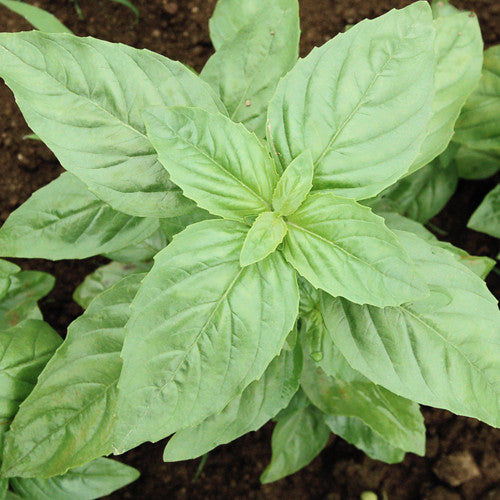Seeds - Basil, Large Leaf Italian OG (SGH)
$4.79
This item may be out of season or currently out of stock. Please check back.
Order info: This item is available for online ordering within Canada. Please choose shipping or local pick-up at check out.
Description: Enormous leaves loaded with Italian Sweet Basil flavour! Highly-recommended variety for salads, pesto and more!
Pack Size: 1 gram
Latin Name: Ocimum basilicum
Alternative Names: Pesto Basil
Main Uses: Culinary
Zone Hardiness: Annual
Exposure: Full sun
Height: 40 cm (16")
Flower Color: White
Flowering Time: Mid to late summer (cut back any flowering stems as soon they appear, trimming well beyond the point of flowering, to encourage strong leafy regrowth... unless flowers are desired).
Certified Organic: USDA Certified Organic
Germination: 5 - 7 days at 21° C.
Sowing: Indoors 4 - 6 weeks before last frost date. Sow 5 - 8 seeds per cell or plug. For best results, fertilize right from first watering with a kelp-based fertilizer such as Sea Magic™. Apply a seedling starter fertilizer such as Evolve Seedling once the second set of true leaves has appeared, and then alternate between the kelp and seedling starter until transplant. Basil can be direct-seeded outdoors in early June, once the soil has warmed and there is no chance of frost. Direct-seeding is an easy way to start healthy basil!
Planting Depth: Surface. Lightly press into the planting medium.
Planting Out: Plant in well-drained fertile soil (in garden or container) once seedlings are established and risk of frost has passed and soil has warmed. This is usually the first week of June in southern Manitoba.
Harvesting & Preserving: Harvest before significant flowering occurs, and harvest often to encourage bushiness. Avoid plucking basil leaves - always cut using sharp scissors. Yields are greatly increased by regular cutting of stem tips. Basil is SO GOOD when used fresh, but may be frozen whole, or in a semi-processed form (e.g. as pesto) for winter use. Drying basil is a challenge because the volatile oils evaporate quickly; that said, some gardeners have great success using a dehydrator or other controlled drying method.
Growing in Containers: Well-suited for containers 15 cm (6") and up. Pots smaller than 15 cm dry out very quickly and are generally not productive.
Fertilizing (Containers): Add 25% quality compost to potting mix; fertilize weekly with a higher nitrogen organic plant food such as Evolve Fish Grow or other organic fish-based fertilizer.
Watering (Containers): Water deeply when the top inch of soil is dry. Monitor daily during hot weather months.
Growing in Mixed Planters: Excellent for mixed herb or veggie pots.
Fertilizing (Garden): Plant into well-drained garden soil, amended yearly with quality compost such as Sea Soil. No additional fertilizer required, although many gardeners continue to apply liquid kelp to herb and veggie gardens right through to harvest.
Watering (Garden): Water to establish (first two weeks). Once established, water weekly to maximize productivity.
Beneficials Attracted to this Plant: Bees love basil!
Garden Companions: Basil and tomatoes are one of the all-time garden companions: Gardener's wisdom suggests that the flavour and quality of the tomato fruits will be improved when basil is planted in close proximity - not to mention how well these two flavours pair in the kitchen! Basil is often inter-planted with other culinary herbs and vegetables, or in themed gardens such as a "pizza patch": oregano, basil, tomatoes and peppers. Don't be shy to plant basil among your ornamental plants as well - the fragrance of fresh sweet basil and the handsome leaves add a creative and cheery feel to any landscape.
Special Requirements for Cold Climate Gardeners: Basil is very sensitive to cold and all precautions should be taken to avoid chills!
Pest/Disease Issues: Basil seedlings can be quite prone to fungal and bacterial diseases if they are started under conditions that are cool, too wet, lacking excellent air circulation, or lacking strong daylight hours. We recommend starting basil seeds just a few weeks before planting out time unless you have grow lights. Mature basil plants can be tempting food for larger pests such as rabbits, and smaller creatures such as grasshoppers and slugs. A top application of diatomaceous earth (GreenEarth® Slug and Bug Killer Dust) is an effective, non-toxic means of keeping slugs and snails from harming plants. Growing your basil in pots may be an excellent solution if garden pests, rabbits, or deer are a problem.
Suitability for Indoors: Basil can be grown indoors in a very sunny window during the spring and summer months. During low light, seasons grow lights are required.
Exposure: Full sun or grow lights.
What about Grow Lights? A simple fluorescent light dramatically improves the success of basil indoors.
General Indoor Care: The sunniest possible location or grow lights are critical to the success of basil indoors. During the low daylight months of winter, grow lights are imperative. Use a well-drained potting mix amended with 25% compost such as Sea Soil. Avoid growing basil near heat vents or air conditioning vents, as the dry air will not be good for the plants.
Indoor Container Suggestions: Minimum 6" pot, with drainage holes. Mixed planters are not recommended for indoors.
Winter Fertilizing: Under lights, fertilize weekly with a higher nitrogen organic plant food such as Evolve Fish Grow.
Winter Watering: Under lights, water deeply every few days. If plants don't seem to be drying out, increase the air circulation.
Special Instructions: Harvest and cut frequently to increase bushiness and vigour of indoor basil.




